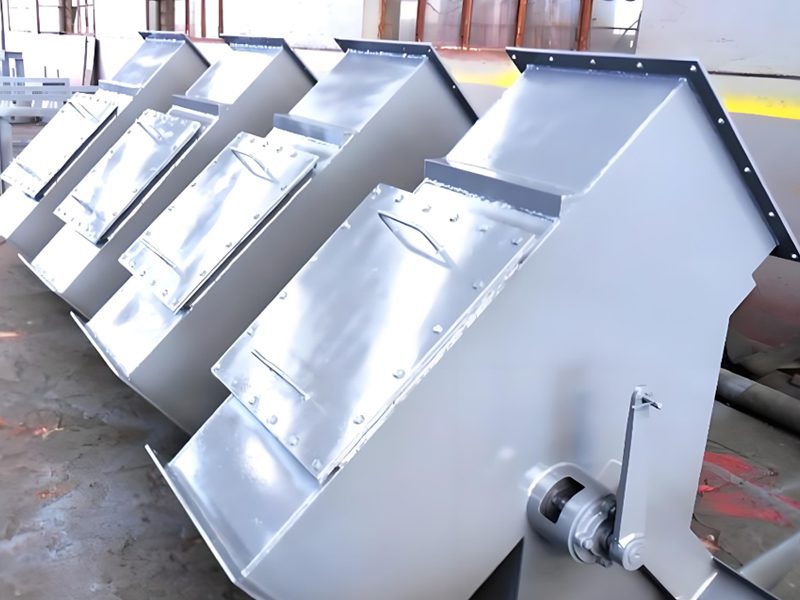Introduction to Diverter Flap Valves
Diverter flap valves represent a critical class of industrial components designed for precision material flow control in demanding environments. These specialized valves serve as the traffic directors of pneumatic conveying and bulk material handling systems, enabling operators to redirect product flow between multiple destinations with exceptional reliability. As industries increasingly prioritize operational efficiency and material conservation, diverter flap valves have become indispensable assets in facilities ranging from food processing plants to chemical manufacturing and power generation.
The core function of a diverter flap valve is elegantly simple: a pivoting flap inside a sealed housing shifts position to direct material flow into one of two or more pathways. This seemingly straightforward mechanism solves complex logistical challenges in material handling systems, preventing cross-contamination, reducing equipment footprint, and optimizing production flexibility. With global industries pushing toward automated, continuous processing, the strategic implementation of diverter valves often marks the difference between efficient operations and costly bottlenecks.
How Diverter Flap Valves Work: The Engineering Behind Flow Control
Core Operating Principle
At the heart of every diverter flap valve is a pivoting mechanism that operates like a railway switch for bulk materials. The valve body features a primary inlet and multiple outlet ports. A hinged flap—typically constructed from durable metal or engineered polymers—rotates within the housing to create a sealed passage to the selected outlet:
- Actuation phase: Electric, pneumatic, or hydraulic actuators receive signals to reposition the flap
- Rotation phase: The flap pivots smoothly to align with the desired outlet pathway
- Sealing phase: The flap creates an airtight seal against the non-selected outlets
- Material flow: Bulk materials travel through the newly formed channel to their destination
Key Components Breakdown
| Componente | Função | Materiais comuns |
|---|---|---|
| Flap | Directs material flow | Stainless steel, abrasion-resistant steel, UHMWPE |
| Habitação | Contains pressure and material | Carbon steel, stainless steel, aluminum |
| Seals | Prevent leakage | Buna-N, EPDM, Viton®, PTFE |
| Shaft | Transfers actuator motion | Hardened steel, stainless steel |
| Actuator | Provides motion force | Pneumatic cylinders, electric motors |
O zero-gap design in premium valves prevents material buildup, while wear-resistant liners extend service life in abrasive applications. Modern valves incorporate position sensors to confirm flap alignment and provide feedback to control systems.
Types of Diverter Flap Valves: Finding the Right Configuration
1. Two-Way Diverters
- Função: Direct flow between two destinations
- Aplicações: Basic splitting operations, filling alternate containers
- Caraterísticas: Simple construction, cost-effective solution for uncomplicated systems
2. Three-Way Diverters
- Função: One input to two outputs OR two inputs to one output
- Aplicações: Blending operations, combining material streams, system redundancy
- Caraterísticas: More complex design with greater flexibility
3. Multi-Port Rotary Valves
- Função: Single input to multiple outputs (3-8 destinations)
- Aplicações: Large-scale distribution systems, sorting operations
- Caraterísticas: Radial design, sequential or selective distribution capability
4. Specialty Diverters
- High-Temperature Models: Feature heat-resistant materials and expansion joints
- Sanitary Valves: Polished surfaces, crevice-free designs for food/pharma
- Explosion-Proof Valves: ATEX-compliant for combustible dust environments

Aplicações críticas em todos os sectores
Diverter flap valves solve complex flow challenges across industrial sectors:
- Food & Beverage Processing: Directing grains, powders, and ingredients between mixers, dryers, and packaging lines while maintaining hygiene standards
- Pharmaceutical Manufacturing: Preventing cross-contamination when filling different product lines or transferring active pharmaceutical ingredients (APIs)
- Cement & Building Materials: Handling abrasive materials like fly ash, cement powder, and aggregates in batching plants
- Plastics Production: Distributing plastic pellets to multiple molding machines or silos
- Processamento químico: Controlling flow of corrosive or hazardous materials between reactors and storage
- Produção de energia: Managing fly ash removal and directing biomass fuel streams
- Minas e minerais: Transporting ores and processed minerals through complex beneficiation circuits
Top 7 Benefits of Modern Diverter Valves
Eficiência operacional
Enable continuous processing without shutdowns for line switchingSpace Optimization
Replace multiple valves and chutes with a single compact unitConservação de materiais
Eliminate product loss during direction changes with tight sealsReduced Contamination Risk
Prevent cross-contact between different materials or batchesEnhanced System Flexibility
Quickly adapt processes to changing production requirementsAutomation Compatibility
Integrate seamlessly with PLC controls and IIoT monitoring systemsVida útil prolongada
Durable designs withstand abrasive, corrosive, and high-pressure conditions
Selecting the Right Diverter Flap Valve: 10 Critical Factors
Choosing the optimal diverter involves careful analysis of your specific application requirements:
- Caraterísticas do material
- Particle size, abrasiveness, moisture content, and flow properties
Special considerations for explosive dusts or fragile products
Flow Parameters
- Temperature range (cryogenic to 1000°F+)
- Pressure differentials across the valve
Volumetric flow rates and velocity
Housing Design
- Round housings for optimal flow dynamics
- Square/rectangular designs for space constraints
Radiused corners to prevent material buildup
Sealing Technology
- Resilient seals for standard applications
- Metal-to-metal sealing for extreme temperatures
Inflatable seals for fugitive dust control
Actuation System
- Pneumatic for explosive environments
- Electric for precise control
Hydraulic for high-torque requirements
Material of Construction
- 316L stainless for corrosive materials
- Carbon steel with ceramic lining for abrasion resistance
FDA-compliant finishes for sanitary applications
Maintenance Accessibility
- Quick-release clamps for housing access
- Top-entry shaft designs for in-place servicing
Modular component replacement
Position Verification
- Limit switches for position confirmation
- Proximity sensors for remote monitoring
Smart sensors with predictive maintenance capabilities
Industry Compliance
- FDA 21 CFR Part 11 for pharmaceuticals
- EHEDG/3-A sanitary standards
ATEX/IECEx for explosive atmospheres
Total Cost of Ownership
- Initial investment vs. maintenance costs
- Energy consumption of actuation system
- Expected service life and component replacement intervals
Installation & Maintenance Best Practices
Proper installation ensures optimal performance:
- Positioning Guidelines
- Install vertical sections with adequate straight-run entry/exit
- Support valve independently from connected ductwork
Maintain alignment with connecting piping
Commissioning Checks
- Verify smooth flap movement without binding
- Confirm air-tight seals in closed positions
Test position indicators with control system
Preventative Maintenance Routine
- Monthly: Inspect seals and actuation linkages
- Quarterly: Check for erosive wear and alignment
- Annually: Rebuild actuator assemblies
Troubleshooting Common Issues:
- Material Leakage: Check seal integrity, alignment, and actuator force
- Incomplete Diversion: Verify no obstructions in valve housing
- Erratic Operation: Inspect position sensors and controller signals
- Excessive Wear: Evaluate material abrasiveness versus lining suitability
Emerging Technology & Industry Innovations
The diverter valve market continues advancing with significant developments:
- Smart Valve Systems: Valves with embedded sensors measuring temperature, vibration, and operational cycles, transmitting data to predictive maintenance platforms
- Advanced Sealing Solutions: Self-adjusting seals that compensate for wear and thermal expansion
- Additive Manufacturing: 3D-printed housings with optimized flow paths for specific materials
- Lightweight Composite Housings: Reducing weight by 40% while maintaining pressure ratings
- Robotic Integration: Valves designed with standardized interfaces for automated changeover systems
- Energy Recovery Actuators: Systems capturing kinetic energy during valve closure to power other components
Conclusion: Optimizing Material Flow in Modern Industry
Diverter flap valves remain essential components for industrial processes seeking efficiency, flexibility, and reliability. Their evolution from simple mechanical diverters to sophisticated flow management systems illustrates their critical role in modern manufacturing. By understanding the operational principles, application requirementse selection criteria outlined in this guide, engineers and operations managers can implement solutions that reduce downtime, conserve materials, and enhance system performance.
As material handling systems grow increasingly complex with automation and Industry 4.0 integration, diverter valves will continue to evolve. The next generation of smart, connected valves promises unprecedented levels of operational insight and control, turning material flow management into a strategic advantage rather than a mechanical necessity.

